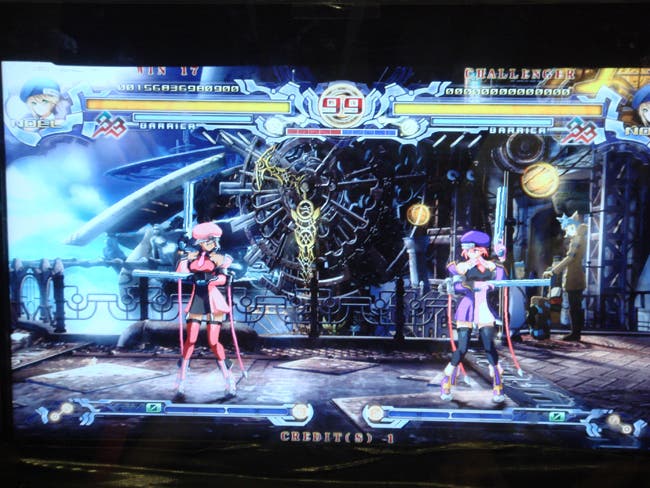BlazBlue: Calamity Trigger
Thank goodness for arcades.
What does stand out about the character roster is the amount of effort that has gone into giving the characters a tangible personality. The back-stories are particularly strong and shrewdly implemented. For instance, Noel and Jin's speech changes when they meet in battle, even extending to things they shout when throwing projectiles.
The first thing that's apparent about BlazBlue's fighting system is that Arc System has stripped away some of their Guilty Gear eccentricities. That's not to say it doesn't bear many of its older cousin's hallmarks. Air recoveries, double jumps and crazy aerial rave combos are all present, but on a base level it's a more accessible first outing.
With a layout that now matches an SNK format, the game features three main buttons for attack - light, middle and heavy - with the fourth button assigned to 'Drive'. In a genre where almost everything has been tried in one form or another, originality is tough to come by. BlazBlue's hook is the way the Drive button is responsible for unique attacks assigned to each character. For example, Ragna's Drive will absorb his opponent's energy, while Jin's Drive will freeze anyone coming into contact with him.
Although it's commonplace that fighting game characters have distinct abilities, the Drive system is what makes BlazBlue really interesting. Drive moves don't do enough damage to unbalance the game, and need to be carefully integrated into combos and timed attacks to be most effective. Noel isn't particularly powerful, but her Drive is focused around combo-extending, meaning she can string together some of the more punishing sequences, while Litchi makes up for not having too many long-range attacks by sending her possessed staff to do the dirty work. One of the most innovative skill-sets belongs to Rachel, who can control the wind and in turn the actual physics of the match. If she throws an opponent, she can utilise the wind to reel the character back in for a follow-up combo.

A lot of BlazBlue is governed by gauges; a Heat Gauge, a Barrier Guard gauge and a Guard Libra gauge. You're damn right it's confusing. Arc System, love it or loathe it, can't resist tinkering with common formulas in the pursuit of innovation. Fortunately it's not as complex as it first seems, with one gauge simply managing guard crushes while the other allows for a more effective method of blocking. The Heat gauge is the one you'll be watching the most, which, as well as storing supers, can be used to break out of any combo in the game at a serious detriment to your character's strength.
Although some efforts have been made to win new followers, BlazBlue hasn't completely shaken off its Guilty Gear shackles. Compared to the more basic approach of Street Fighter IV and the impending King of Fighters XII, it only has niche appeal by comparison. As a brand new IP it's still a terrific first outing, but you can't help but feel that the refinements in the next couple of iterations will make for a better-rounded game.
It would've been nice to see Arc System break away from the familiar look and feel of Guilty Gear, but after extended play BlazBlue reveals itself to be reasonably exclusive in its characteristics. Whether or not it will be enough to convince players to give it the recognition it deserves, only time will tell.
Regardless, Arc System has proven itself as a developer of undeniable ability, capable of successfully integrating fresh ideas into existing templates, and serving up fighting games of immense creativity. BlazBlue may even convert some to the cause, but certainly not all.








